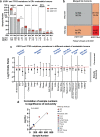Mutual exclusivity of ESR1 and TP53 mutations in endocrine resistant metastatic breast cancer
- PMID: 35538119
- PMCID: PMC9090919
- DOI: 10.1038/s41523-022-00426-w
Mutual exclusivity of ESR1 and TP53 mutations in endocrine resistant metastatic breast cancer
Abstract
Both TP53 and ESR1 mutations occur frequently in estrogen receptor positive (ER+) metastatic breast cancers (MBC) and their distinct roles in breast cancer tumorigenesis and progression are well appreciated. Recent clinical studies discovered mutual exclusivity between TP53 and ESR1 mutations in metastatic breast cancers; however, mechanisms underlying this intriguing clinical observation remain largely understudied and unknown. Here, we explored the interplay between TP53 and ESR1 mutations using publicly available clinical and experimental data sets. We first confirmed the robust mutational exclusivity using six independent cohorts with 1,056 ER+ MBC samples and found that the exclusivity broadly applies to all ER+ breast tumors regardless of their clinical and distinct mutational features. ESR1 mutant tumors do not exhibit differential p53 pathway activity, whereas we identified attenuated ER activity and expression in TP53 mutant tumors, driven by a p53-associated E2 response gene signature. Further, 81% of these p53-associated E2 response genes are either direct targets of wild-type (WT) p53-regulated transactivation or are mutant p53-associated microRNAs, representing bimodal mechanisms of ER suppression. Lastly, we analyzed the very rare cases with co-occurrences of TP53 and ESR1 mutations and found that their simultaneous presence was also associated with reduced ER activity. In addition, tumors with dual mutations showed higher levels of total and PD-L1 positive macrophages. In summary, our study utilized multiple publicly available sources to explore the mechanism underlying the mutual exclusivity between ESR1 and TP53 mutations, providing further insights and testable hypotheses of the molecular interplay between these two pivotal genes in ER+ MBC.
© 2022. The Author(s).
Conflict of interest statement
All the authors declare no non-financial competing interests. A.V.L. is employee and consultant with UPMC Enterprises, and member of the Scientific Advisory Board, Stockholder and receives compensation from Ocean Genomics. The remaining authors declare no financial competing interests.
Figures






Similar articles
-
Genomic and clinical landscape of metastatic hormone receptors-positive breast cancers carrying ESR1 alterations.ESMO Open. 2024 Oct;9(10):103731. doi: 10.1016/j.esmoop.2024.103731. Epub 2024 Oct 1. ESMO Open. 2024. PMID: 39357123 Free PMC article.
-
Mutation site and context dependent effects of ESR1 mutation in genome-edited breast cancer cell models.Breast Cancer Res. 2017 May 23;19(1):60. doi: 10.1186/s13058-017-0851-4. Breast Cancer Res. 2017. PMID: 28535794 Free PMC article.
-
ESR1 mutations: Moving towards guiding treatment decision-making in metastatic breast cancer patients.Cancer Treat Rev. 2017 Jan;52:33-40. doi: 10.1016/j.ctrv.2016.11.001. Epub 2016 Nov 10. Cancer Treat Rev. 2017. PMID: 27886589 Review.
-
Longitudinal Molecular Imaging of Progesterone Receptor Reveals Early Differential Response to Endocrine Therapy in Breast Cancer with an Activating ESR1 Mutation.J Nucl Med. 2021 Apr;62(4):500-506. doi: 10.2967/jnumed.120.249508. Epub 2020 Aug 28. J Nucl Med. 2021. PMID: 32859700 Free PMC article.
-
p53 in breast cancer subtypes and new insights into response to chemotherapy.Breast. 2013 Aug;22 Suppl 2:S27-9. doi: 10.1016/j.breast.2013.07.005. Breast. 2013. PMID: 24074787 Review.
Cited by
-
MicroRNA‑96 promotes the proliferation and migration of breast cancer cells by inhibiting Smad7 expression.Oncol Lett. 2025 Jan 22;29(3):151. doi: 10.3892/ol.2025.14897. eCollection 2025 Mar. Oncol Lett. 2025. PMID: 39898288 Free PMC article.
-
Real-world clinical multi-omics analyses reveal bifurcation of ER-independent and ER-dependent drug resistance to CDK4/6 inhibitors.Nat Commun. 2025 Jan 22;16(1):932. doi: 10.1038/s41467-025-55914-x. Nat Commun. 2025. PMID: 39843429 Free PMC article.
-
CDK4/6i-treated HR+/HER2- breast cancer tumors show higher ESR1 mutation prevalence and more altered genomic landscape.NPJ Breast Cancer. 2024 Feb 22;10(1):15. doi: 10.1038/s41523-024-00617-7. NPJ Breast Cancer. 2024. PMID: 38388477 Free PMC article.
-
Association of ESR1 germline variants with TP53 somatic variants in breast tumors in a genome-wide study.medRxiv [Preprint]. 2023 Dec 6:2023.12.06.23299442. doi: 10.1101/2023.12.06.23299442. medRxiv. 2023. Update in: Cancer Res Commun. 2024 Jun 27;4(6):1597-1608. doi: 10.1158/2767-9764.CRC-24-0026. PMID: 38106140 Free PMC article. Updated. Preprint.
-
Real-World Use of Highly Sensitive Liquid Biopsy Monitoring in Metastatic Breast Cancer Patients Treated with Endocrine Agents after Exposure to Aromatase Inhibitors.Int J Mol Sci. 2023 Jul 13;24(14):11419. doi: 10.3390/ijms241411419. Int J Mol Sci. 2023. PMID: 37511178 Free PMC article.
References
-
- Siegel RL, Miller KD, Fuchs HE, Jemal A. Cancer statistics, 2021. CA: Cancer J. Clin. 2021;71:7–33. - PubMed
Grants and funding
LinkOut - more resources
Full Text Sources
Research Materials
Miscellaneous

